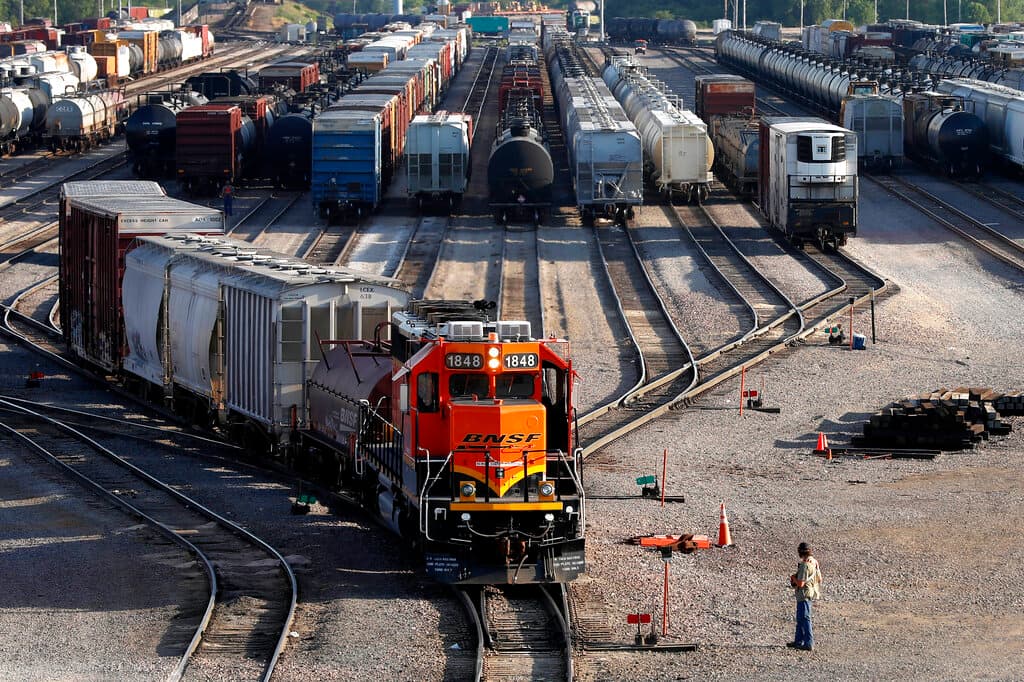Looming Railroad Strike Could Cripple American Economy
Unless all parties can come to an agreement by next week’s deadline, a railroad strike that would touch on every corner of the U.S. economy seems imminent.

If it seems like more and more unionized American workers are on strike or threatening to strike of late, it’s because they are, and it soon could get worse.
Schoolchildren in Seattle were locked out of class for the third day Friday because teachers there are on strike. Nursing home workers in Pennsylvania are on strike, as are faculty members at Eastern Michigan University. Hotel workers in Hollywood, therapists in Hawaii, and nurses in Michigan are all on strike.
Another strike is looming, and it could be the biggest yet — and the worst for the American economy. Unless a deal is reached between several railroad workers’ unions and the companies they work for by the end of next week, a strike that would bring the economy to its knees appears likely.
The president of the American Association of Railroads, which represents rail companies, Ian Jefferies, said that unless all parties can come to an agreement by next week’s deadline, Congress should step in to avert a service interruption that would touch on every corner of the American economy.
Several other industry groups, ranging from fertilizer makers to retail groups, have joined Mr. Jefferies in urging Congress to act.
In July, in an effort to tamp down the prospect of a strike, President Biden appointed a special “Presidential Emergency Board” to help mediate between the rail companies and their unions. The agreement called for a 60-day “cooling off” period during which the unions were not allowed to go on strike. That period ends at midnight on September 16.
Late last week, the freight rail companies reached an agreement with 6,000 rail workers in two unions representing electrical workers and dispatchers. The agreement calls for an immediate 14 percent wage increase and further increases totaling 24 percent by the end of 2024, along with five annual lump sum payments of $1,000 each.
With that agreement, the companies have now settled with five of the 12 unions representing 21,000 railroad workers. There are, however, about 90,000 workers without agreements.
A report Thursday by Mr. Jefferies of AAR says a strike would virtually cripple the movement of goods — as well as commuters — on roughly 140,000 miles of railroad, and cost the American economy as much as $2 billion a day. Store shelves would immediately start thinning out. New cars would be in neutral at ports. Farm products would be stuck in fields. Manufacturing plants would be unable to source many of the raw materials on which they depend.
The railroad association says it would be another supply chain nightmare, and there would be nothing to pick up the slack.
“In the event of a railroad shutdown, trucks could not take more than a small fraction of what would otherwise move by rail in the short term,” the association says. “About 467,000 additional longhaul trucks per day would be needed to handle the freight. Currently, neither the trucks nor the truck drivers necessary to meet this demand are available.”
The rail companies have offered the holdout unions deals similar to those signed with the electrical workers and dispatchers, but so far those overtures have been rebuffed. The proposed deal would increase the average pay of a rail employee to $110,000 per year by the end of the contract — $160,000 per year if benefits like health care and retirement plans are considered.
It would be the most substantial wage increase for rail workers in the last 40 years, industry officials say.
Unions representing conductors and engineers, among others, have so far rejected the offer, stating that some rules proposed by the rail companies regarding “on-call” status of some workers are unacceptable.
The president of the largest union, known as Smart, Jeremy Ferguson, said last week that while the deal proposed is an improvement over previous offers, “the recommendations do not go far enough to provide our members with the quality of life that they have earned, and that both they and their families deserve.”

